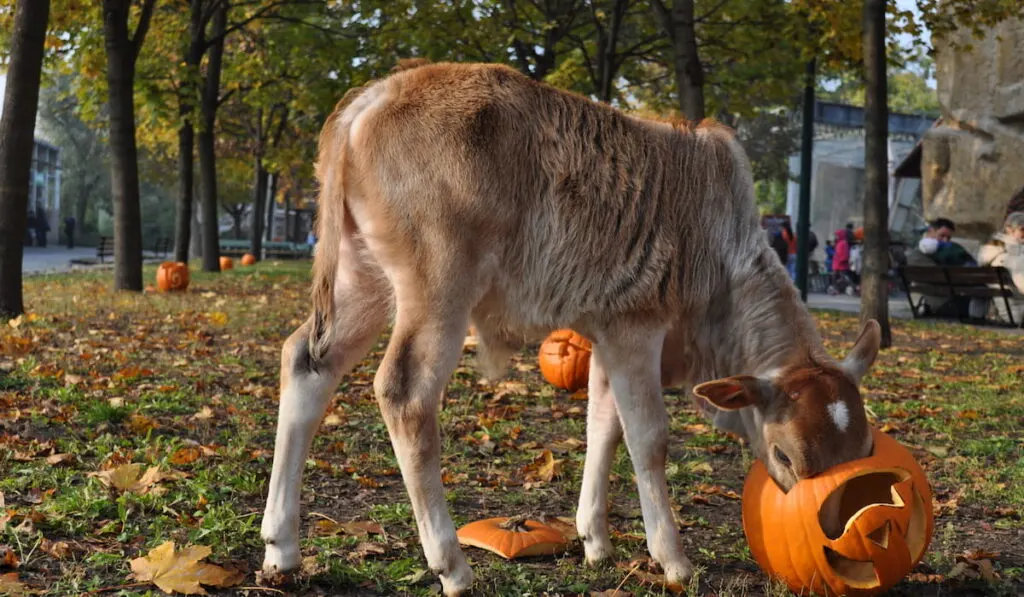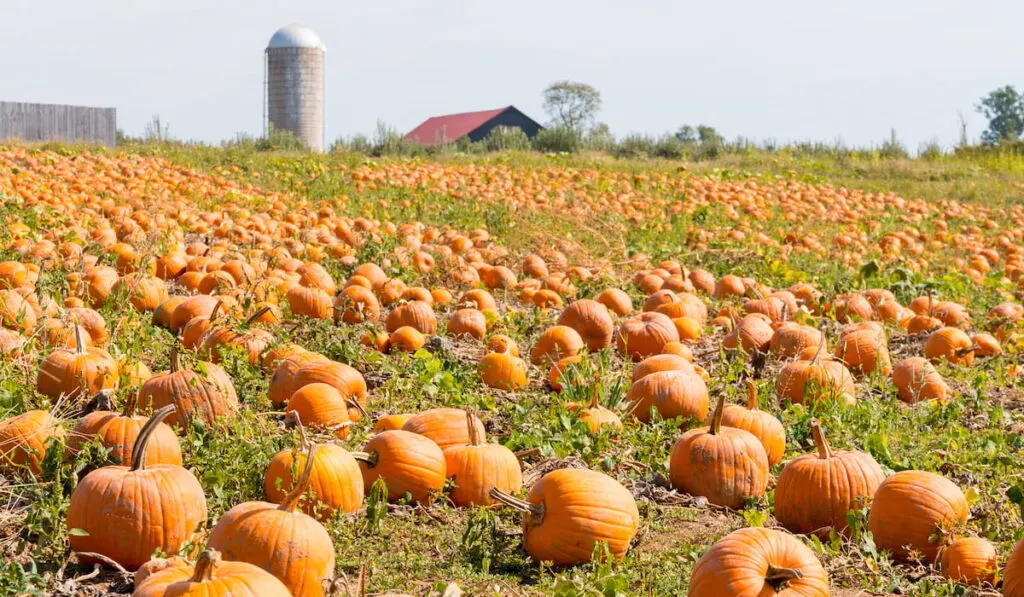Deer are fascinating woodland animals with excellent hearing and an amazing sense of smell that helps them easily escape predators and find food for themselves.
They are herbivores with a pretty varied diet. Today we’ll learn more about how pumpkins fit into their menu and if it’s a good food choice for deer.
Table of Contents
What Do Deer Usually Eat?
Deer are forest animals that feed on sedges, small shrubs, grasses, the shoots and leaves of trees and some other woody plants they come across. They eat berries and fruit from time to time and also tend to consume tree bark when they can’t find something better.
These animals are similar to cows – they have one main stomach and three “false” ones. Deer actually chew their cud in order to fully digest the food.
It’s really not that common, but deer have been known to steal and consume the eggs of ground-nesting birds. This probably happens when the animal is unable to get a proper source of all the nutrients it needs from its regular diet.
The eating habits of deer can negatively affect a woodland ecosystem. When deer are eating parts of young trees, they can stop the growth of new trees and a process of natural regeneration of new woodlands in general.
Also, big numbers of deer tend to consume plants which other animals like insects and birds depend on, whether for shelter or for food.

Can Deer Eat Pumpkins?
Despite being wild herbivore animals that prefer to feed in the woodland, they also tend to forage in trash bins or gardens when they can’t find food they need elsewhere.
So, what happens when they find pumpkins? Can deer eat pumpkins?
Deer can safely eat pumpkins. In fact, their diet mainly consists of fruit and vegetation, which means pumpkins are a great solution for them.
Pumpkins are a healthy and highly nutritious choice that are particularly rich in vitamins, potassium, manganese, and other nutrients animals need to function normally.
Deer will gladly eat both pumpkin plants and the fruit. Their favorite parts are mostly the guts and seeds inside, although the majority of pumpkin parts are edible, including leaves, flowers, and the squishy part of the rind.
Are Pumpkins Safe For Deer To Eat?
As we have already mentioned, pumpkins are a pretty good and healthy choice for deer.
The different parts of this fruit have different nutritional value. Together with some beneficial nutrients we’ve mentioned above, pumpkin is also packed with fiber—which is an element important for good digestion and better bone health.
The seeds are a great source of fats, which is especially important during the harsh winter conditions when there tends to not be enough food for the animals in general.
However, old rotten pumpkins can be unsafe for an animal to consume. They carry mold which can make deer ill and cause them health problems.
So, pumpkins are safe for deer, but only when they’re fresh.
If you see mold on your pumpkin, perhaps you should consider using it for compost rather than feeding deer with it. Also, if you have old Halloween pumpkins, make sure to remove any wax and candles so deer can safely eat them.

When Will Deer Eat Pumpkins?
Their feeding pattern changes along with the seasons. With this in mind, deer will eat pumpkins throughout the whole year, but with a focus on different parts.
During the hot summer months, deer are more likely to consume the leaves of the pumpkins. When the fall comes and as the pumpkin matures, deer will switch to eating the fruit itself.
People mostly harvest pumpkins around Halloween, so be ready to see deer coming for your supply during that period.
How To Feed Deer Pumpkins
If you want to get deer to eat pumpkins, you can pop open the fruit so they can easily access what’s inside. It’s definitely better to cut fruits and scatter them in forest areas rather than leaving them in your trashcans or on your porch.
Still, even if you don’t cut it, deer are perfectly capable of eating pumpkins without any help. The animal has a mouth specifically designed for the consumption of various vegetation and fruits such as pumpkin.
Deer will most likely start with the green parts like buds, leaves, and immature pumpkin fruits. When pumpkins get fully grown, it is harder for an animal to eat them.
However, deer will then gnaw away at the skin to get to those soft, delicious parts hiding inside.
When you’re offering pumpkins to deer, be prepared for other hungry wildlife that might get attracted to such a delicious meal. For example, you could expect animals such as foxes, squirrels, raccoons, bears, rodents, opossums, and more.

How To Stop Deer From Eating Your Pumpkins
Although it’s nice when an animal eats something it enjoys, we understand the frustration when you find out it caused damage to your garden and crops.
Deer are cute, but often rather hungry so they’ll eat the flowers off a bush, the leaves off a tree, and a bunch of other things in your garden.
For instance, during the summertime, deer can completely destroy a growing crop of young fruits and shoots. Otherwise, they’ll wait until the fruits are ripe and take them off their vines.
So, how can you stop deer from eating your pumpkins? Here are some ways to do that:
- Build a fence that will surround your entire pumpkin patch. However, not all fences will keep your crops protected.
Before jumping a fence, deer will try to go around or under it. This clever animal will easily leap over a classical chain-link fence. Go for an electrical wire fence that has horizontal wires placed at 10, 20, and 30 inches off the ground.
- Cover your patch with a tree net. Sometimes you can find it sold as a bird net.
This is a great choice if a fence is too hard to install or simply too expensive. Also, it will still be easy to water the pumpkins through the net.
- Plant marigolds around the perimeter of the area you want to protect. Deer are not fond of marigold’s scent, which is why they’ll probably stay away. You can combine this method together with any of the other ones.
- Buy a chemical deer repellent and apply it to the perimeter of the patch. This is another method you can combine with others in order to ensure better protection for your pumpkins.

Some Final Words
Deer can and really like to eat pumpkins. They are herbivores that like to eat various vegetation and tasty fruits. Pumpkins are a particularly safe and beneficial food for deer, especially because they’re so rich in valuable nutrients.
Pumpkins are also packed with fats, which is especially helpful when it’s cold outside. In harsh winter conditions, animals may struggle to find food, which is why they need extra fatty foods to help them remain warm and healthy.
If you have some extra pumpkins you’d like to share with deer in the forest, you can always cut them into pieces and serve them somewhere out in the woods. This is a better option than leaving the food around your house.
Avoid giving them rotten food, since it can make them ill.
Deer eat pumpkins throughout the whole year. In the summer, they’ll consume leafy parts, while in the fall they’ll go for ripened fruits. They’re really into fruits so consider protecting your pumpkin patch if you notice there are deer around your house.
Sources:
- https://naturesmace.com/do-deer-eat-pumpkins/
- https://www.woodlandtrust.org.uk/blog/2019/05/what-deer-eat/
- https://www.healthline.com/nutrition/pumpkin#TOC_TITLE_HDR_2
- https://www.livescience.com/51154-deer-facts.html
- https://birdsandwild.com/do-deer-eat-pumpkins/
- https://www.gardenguides.com/98721-keep-deer-away-pumpkins.html
